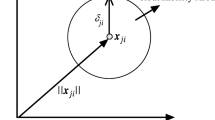Abstract
In this paper, we have formulated a Laplacian Least Squares Twin Support Vector Machine called Lap-LST-KSVC for semi-supervised multi-category k-class classification problem. Similar to Least Squares Twin Support Vector Machine for multi-classification(LST-KSVC), Lap-LST-KSVC, evaluates all the training samples into “1-versus-1-versus-rest” classification paradigm, so as to generate ternary output {−1, 0, +1}. Experimental results prove the efficacy of the proposed method over other inline Laplacian Twin Support Vector Machine(Lap-TWSVM) in terms of classification accuracy and computational time.




Similar content being viewed by others
References
Melacci S, Belkin M (2011) Laplacian support vector machines trained in the primal. J Mach Learn Res 12:1149–1184
Blum A, Mitchell T (1998) Combining labeled and unlabeled data with co-training. In: Inproceedings of the eleventh annual conference on Computational learning theory, pp 92–100
Nigam K, McCallum AK, Thrun S, Mitchell T (2000) Text classification from labeled and unlabeled documents using em. Mach Learn 39(2-3):103–134
Zhu X (2005) Semi-supervised learning literature survey. Technical Report 1530, Computer Sciences, University of Wisconsin-Madison
Jayadeva, Khemchandani R, Chandra S (2007) Twin support vector machines for pattern classification. IEEE Transactions Pattern Analysis and Machine Intelligence 29(5):905– 910
Kumar MA, Gopal M (2009) Least squares twin support vector machines for pattern classification. Expert Syst Appl 36(4):7535–7543
Zhang Z, Zhen L, Deng N, Tan J (2014) Sparse least square twin support vector machine with adaptive norm. Appl Intell 41:10971107
Qi Z, Tian Y, Shi Y (2012) Laplacian twin support vector machine for semi-supervised classification. Neural Netw 35:46–53
Chen WJ, Shao YH, Deng NY, Feng ZL (2014) Laplacian least squares twin support vector machine for semi-supervised classification. Neurocomputing 145:465–476
Xu Y, Guo R, Wang L (2013) A twin multi-class classification support vector machine. Cognitive Computation 5(4):580–588
Angulo C, Parra X, Catala A (2003) K-SVCR: a support vector machine for multi-class classification. Neurocomputing 55(1):57–77
Nasiri JA, Charkari NM, Jalili S (2015) Least squares twin multi-class classification support vector machine. Pattern Recogn 48(3):984–992
Belkin M, Niyogi P, Sindhwani V (2006) Manifold regularization: a geometric framework for learning from labeled and unlabeled examples. J Mach Learn Res 7:2399–2434
Suykens JAK, Vandewalle J (1999) Least squares support vector machine classifiers. Neural Process Lett 9(3):293–300
Mangasarian OL, Wild EW (2001) Proximal support vector machine classifiers. In: proceedings KDD-2001: Knowledge Discovery and Data Mining. Citeseer
Chen X, Yang J, Ye Q, Liang J (2011) Recursive projection twin support vector machine via within-class variance minimization. Pattern Recogn 44(10):2643–2655
Golub GH, Loan CFV (2012) Matrix computations, vol 3. JHU Press
Asuncion A, Newman D (2007) UCI machine learning repository
Duda RO, Hart PE, Stork DG (2001) Pattern classification. 2nd Edn New York
Wang JZ, Li J, Wiederhold G (2001) Simplicity: Semantics-sensitive integrated matching for picture libraries. IEEE Transactions Pattern Analysis and Machine Intelligence 23(9):947– 963
Oliva A, Torralba A (2001) Modeling the shape of the scene: a holistic representation of the spatial envelope. Int J Comput Vis 42(3):145–175
Pickard R, Graszyk C, Mann S, Wachman J, Pickard l, Campbell L (1995) Vistex database. Media Lab MIT, Cambridge
Liu GH, Zhang L, Hou YK, Li ZY, Yang JY (2010) Image retrieval based on multi-texton histogram. Pattern Recogn 43(7):2380–2389
Zhao Y, Jia W, Hu RX, Min H (2013) Completed robust local binary pattern for texture classification. Neurocomputing 106 :68–76
Acknowledgment
We are thankful to Prof. Suresh Chandra for his encouragement during the preparation of our manuscript. The authors would also like to thank the editor and the anonymous reviewers for their valuable comments.
Author information
Authors and Affiliations
Corresponding author
Rights and permissions
About this article
Cite this article
Khemchandani, R., Pal, A. Multi-category laplacian least squares twin support vector machine. Appl Intell 45, 458–474 (2016). https://doi.org/10.1007/s10489-016-0770-6
Published:
Issue Date:
DOI: https://doi.org/10.1007/s10489-016-0770-6




